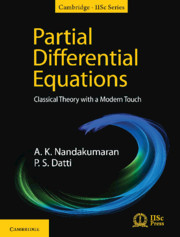Book contents
- Frontmatter
- Dedication
- Contents
- List of Illustrations
- Preface
- Acknowledgments
- Notations
- Chapter 1 Introduction
- Chapter 2 Preliminaries
- Chapter 3 First-Order Partial Differential Equations: Method of Characteristics
- Chapter 4 Hamilton–Jacobi Equation
- Chapter 5 Conservation Laws
- Chapter 6 Classification of Second-Order Equations
- Chapter 7 Laplace and Poisson Equations
- Chapter 8 Heat Equation
- Chapter 9 One-Dimensional Wave Equation
- Chapter 10 Wave Equation in Higher Dimensions
- Chapter 11 Cauchy–Kovalevsky Theorem and Its Generalization
- Chapter 12 A Peep into Weak Derivatives, Sobolev Spaces and Weak Formulation
- References
- Index
Chapter 5 - Conservation Laws
Published online by Cambridge University Press: 20 May 2020
- Frontmatter
- Dedication
- Contents
- List of Illustrations
- Preface
- Acknowledgments
- Notations
- Chapter 1 Introduction
- Chapter 2 Preliminaries
- Chapter 3 First-Order Partial Differential Equations: Method of Characteristics
- Chapter 4 Hamilton–Jacobi Equation
- Chapter 5 Conservation Laws
- Chapter 6 Classification of Second-Order Equations
- Chapter 7 Laplace and Poisson Equations
- Chapter 8 Heat Equation
- Chapter 9 One-Dimensional Wave Equation
- Chapter 10 Wave Equation in Higher Dimensions
- Chapter 11 Cauchy–Kovalevsky Theorem and Its Generalization
- Chapter 12 A Peep into Weak Derivatives, Sobolev Spaces and Weak Formulation
- References
- Index
Summary
INTRODUCTION
Many physical laws, for example, conservation of mass, momentum and energy,occur as conservation laws. Dynamics of compressiblefluids, both in one and three dimensions, is a rich source of conservationlaws and offers many problems that are challenging; see, for example,Courant and Friedrichs (1976), Morawetz (1981), Whitham (1974), and Majda(1985). This subject has been one of the most active research fields, bothin the theoretical and computational aspects, for the past more than sixdecades. Because of its important applications in the aerospace engineering,the interest in this field is only growing. Yet, certain theoretical aspectsin the study of systems of conservation laws (e.g., Euler's equationsof gas dynamics) have not been resolved satisfactorily and remain achallenge. The interested reader will find some advanced topics in Smoller(1994), Majda (1985), and Lax (1973), and the references therein.
A conservation law asserts that the rate of change of the totalamount of a substance (e.g., a fluid) in a domain Ω inspace (an interval in the one-dimensional case) is equal to itsflux across the boundary𝜕Ω of the domain Ω. Ifu = u(x, t) denotesthe density of the substance at time t andf the flux, the conservation law is expressed as
where v denotes the outward unit normal on𝜕Ω and dS is thesurface measure on 𝜕Ω. The integral on theright-hand side is the total amount of the outflow of the substance across𝜕Ω, hence the negative sign. Assumingthat u and f are smooth, we obtain usingthe divergence theorem that
SinceΩis an arbitrary domain, by shrinking it to a point, we obtainthe following first-order PDE
satisfied by the density u and the flux f.Equation (5.2) is the conservation law expressed in thedifferentiated form and equation (5.1) in theintegral form.
Note that (5.1) is equivalent to
for all t1 and t2 witht1< t2.
In the present chapter, we consider only a single conservation law in one(space) dimension.
- Type
- Chapter
- Information
- Partial Differential EquationsClassical Theory with a Modern Touch, pp. 111 - 144Publisher: Cambridge University PressPrint publication year: 2020



